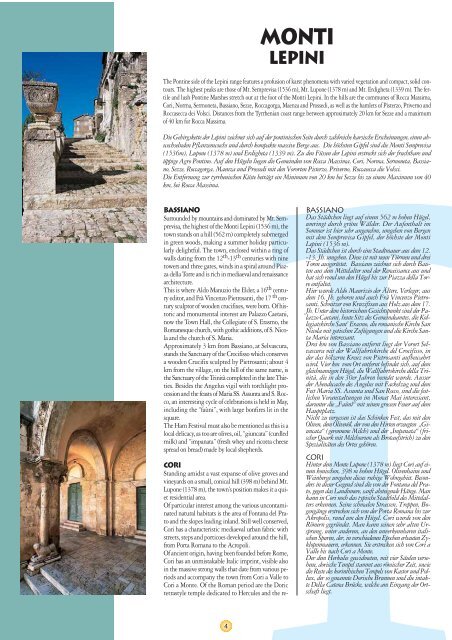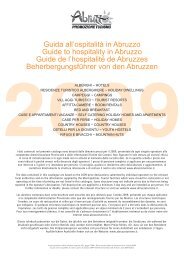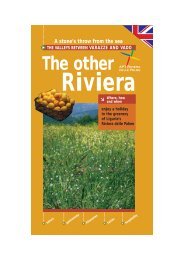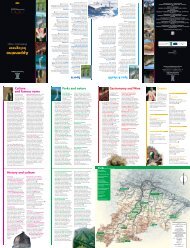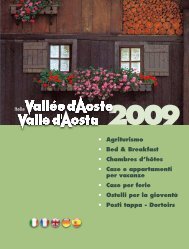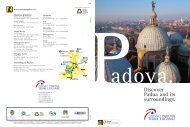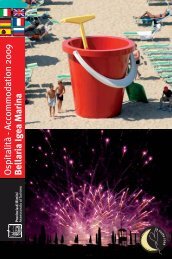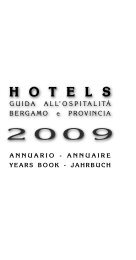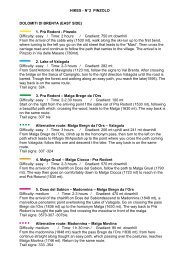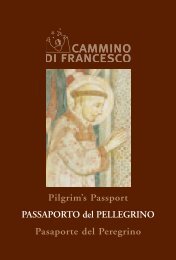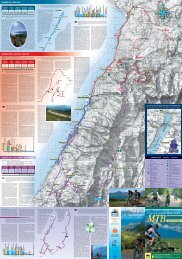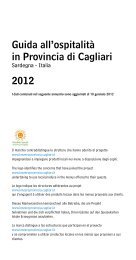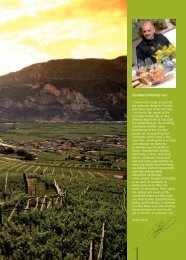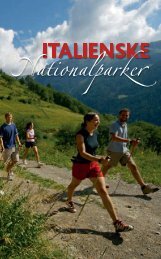Erfolgreiche ePaper selbst erstellen
Machen Sie aus Ihren PDF Publikationen ein blätterbares Flipbook mit unserer einzigartigen Google optimierten e-Paper Software.
Bassiano<br />
Surrounded by mountains and dominated by Mt. Semprevisa,<br />
the highest of the <strong>Monti</strong> <strong>Lepini</strong> (1536 m), the<br />
town stands on a hill (562 m) completely submerged<br />
in green woods, making a summer holiday particularly<br />
delightful. The town, enclosed within a ring of<br />
walls dating from the 12 th -13 th centuries with nine<br />
towers and three gates, winds in a spiral around Piazza<br />
della Torre and is rich in mediaeval and renaissance<br />
architecture.<br />
This is where Aldo Manuzio the Elder, a 16 th century<br />
editor, and Frà Vincenzo Pietrosanti, the 17 th century<br />
sculptor of wooden crucifixes, were born. Of historic<br />
and monumental interest are Palazzo Caetani,<br />
now the Town Hall, the Collegiate of S. Erasmo, the<br />
Romanesque church, with gothic additions, of S. Nicola<br />
and the church of S. Maria.<br />
Approximately 3 km from Bassiano, at Selvascura,<br />
stands the Sanctuary of the Crocifisso which conserves<br />
a wooden Crucifix sculpted by Pietrosanti; about 4<br />
km from the village, on the hill of the same name, is<br />
the Sanctuary of the Trinità completed in the late Thirties.<br />
Besides the Angelus vigil with torchlight procession<br />
and the feasts of Maria SS. Assunta and S. Rocco,<br />
an interesting cycle of celebrations is held in May,<br />
including the “faùni”, with large bonfires lit in the<br />
square.<br />
The Ham Festival must also be mentioned as this is a<br />
local delicacy, as too are olives, oil, “giuncata” (curdled<br />
milk) and “impanata” (fresh whey and ricotta cheese<br />
spread on bread) made by local shepherds.<br />
cori<br />
Standing amidst a vast expanse of olive groves and<br />
vineyards on a small, conical hill (398 m) behind Mt.<br />
Lupone (1378 m), the town’s position makes it a quiet<br />
residential area.<br />
Of particular interest among the various uncontaminated<br />
natural habitats is the area of Fontana del Prato<br />
and the slopes leading inland. Still well conserved,<br />
Cori has a characteristic mediaeval urban fabric with<br />
streets, steps and porticoes developed around the hill,<br />
from Porta Romana to the Acropoli.<br />
Of ancient origin, having been founded before Rome,<br />
Cori has an unmistakable Italic imprint, visible also<br />
in the massive strong walls that date from various periods<br />
and accompany the town from Cori a Valle to<br />
Cori a Monte. Of the Roman period are the Doric<br />
tetrastyle temple dedicated to Hercules and the re-<br />
4<br />
MONTI<br />
LEPINI<br />
The Pontine side of the <strong>Lepini</strong> range features a profusion of karst phenomena with varied vegetation and compact, solid contours.<br />
The highest peaks are those of Mt. Semprevisa (1536 m), Mt. Lupone (1378 m) and Mt. Erdigheta (1339 m). The fertile<br />
and lush Pontine Marshes stretch out at the foot of the <strong>Monti</strong> <strong>Lepini</strong>. In the hills are the communes of Rocca Massima,<br />
Cori, Norma, Sermoneta, Bassiano, Sezze, Roccagorga, Maenza and Prossedi, as well as the hamlets of Pisterzo, Priverno and<br />
Roccasecca dei Volsci. Distances from the Tyrrhenian coast range between approximately 20 km for Sezze and a maximum<br />
of 40 km for Rocca Massima.<br />
Die Gebirgskette der <strong>Lepini</strong> zeichnet sich auf der pontinischen Seite durch zahlreiche karsische Erscheinungen, einen abwechselnden<br />
Pflanzenwuchs und durch kompakte massive Berge aus. Die höchsten Gipfel sind die <strong>Monti</strong> Semprevisa<br />
(1536m), Lupone (1378 m) und Erdigheta (1339 m). Zu den Füssen der <strong>Lepini</strong> erstreckt sich der fruchtbare und<br />
üppige Agro Pontino. Auf den Hügeln liegen die Gemeinden von Rocca Massima, Cori, Norma, Sermoneta, Bassiano,<br />
Sezze, Roccagorga, Maenza und Prossedi mit den Vororten Pisterzo, Priverno, Roccasecca die Volsci.<br />
Die Entfernung zur tyrrhenischen Küste beträgt ein Minimum von 20 km bei Sezze bis zu einem Maximum von 40<br />
km, bei Rocca Massima.<br />
BASSIANO<br />
Das Städtchen liegt auf einem 562 m hohen Hügel,<br />
umringt durch grüne Wälder. Der Aufenthalt im<br />
Sommer ist hier sehr angenehm, umgeben von Bergen<br />
mit dem Semprevisa Gipfel, der höchste der <strong>Monti</strong><br />
<strong>Lepini</strong> (1536 m).<br />
Das Städtchen ist durch eine Stadtmauer aus dem 12.<br />
-13. Jh. umgeben. Diese ist mit neun Türmen und drei<br />
Toren ausgerüstet. Bassiano zeichnet sich durch Bauten<br />
aus dem Mittelalter und der Renaissance aus und<br />
hat sich rund um den Hügel bis zur Piazza della Torre<br />
entfaltet.<br />
Hier wurde Aldo Maurizio der Ältere, Verleger, aus<br />
dem 16. Jh. geboren und auch Frà Vincenzo Pietrosanti,<br />
Schnitzer von Kruzifixen aus Holz aus dem 17.<br />
Jh. Unter dem historischem Gesichtspunkt sind der Palazzo<br />
Caetani, heute Sitz des Gemeindeamtes, die Kollegiatskirche<br />
Sant’ Erasmo, die romanische Kirche San<br />
Nicola mit gotischen Zufügungen und die Kirche Santa<br />
Maria interessant.<br />
Drei km von Bassiano entfernt liegt der Vorort Selvascura<br />
mit der Wallfahrtskirche del Crocifisso, in<br />
der das hölzerne Kreuz von Pietrosanti aufbewahrt<br />
wird. Vier km vom Ort entfernt befindet sich, auf dem<br />
gleichnamigen Hügel, die Wallfahrtskirche della Trinità,<br />
die in den 30er Jahren beendet wurde. Ausser<br />
der Abendwache des Angelus mit Fackelzug und dem<br />
Fest Maria SS. Assunta und San Rocco, sind die festlichen<br />
Veranstaltungen im Monat Mai interessant,<br />
darunter die „Faùnì“ mit seinen grossen Feuer auf dem<br />
Hauptplatz.<br />
Nicht zu vergessen ist das Schinken Fest, das mit den<br />
Oliven, dem Olivenöl, der von den Hirten erzeugten „Giuncata“<br />
(geronnene Milch) und der „Impanata“ (frischer<br />
Quark mit Milchserum als Brotaufstrich) zu den<br />
Spezialitäten des Ortes gehören.<br />
CORI<br />
Hinter dem Monte Lupone (1378 m) liegt Cori auf einem<br />
konischen, 398 m hohen Hügel. Olivenhaine und<br />
Weinberge umgeben dieses ruhige Wohngebiet. Besonders<br />
in dieser Gegend sind die von der Fontana del Prato,<br />
gegen das Landinnere, sanft absteigende Hänge. Man<br />
kann in Cori noch das typische Stadtbild des Mittelalters<br />
erkennen. Seine schmalen Strassen, Treppen, Bogengänge<br />
erstrecken sich von der Porta Romana bis zur<br />
Akropolis, rund um den Hügel. Cori wurde von den<br />
Römern gegründet. Man kann seinen sehr alten Ursprung,<br />
unter anderem, an den unverkennbaren italischen<br />
Spuren, der, in verschiedenen Epochen erbauten Zyklopenmauern,<br />
erkennen. Sie erstrecken sich von Cori a<br />
Valle bis nach Cori a Monte.<br />
Der dem Herkules gewidmeten, mit vier Säulen versehene,<br />
dorische Tempel stammt aus römischer Zeit, sowie<br />
die Reste des korinthischen Tempels von Kastor und Pollux,<br />
der so genannte Dorische Brunnen und die intakte<br />
Della Catena Brücke, welche am Eingang der Ortschaft<br />
liegt.


